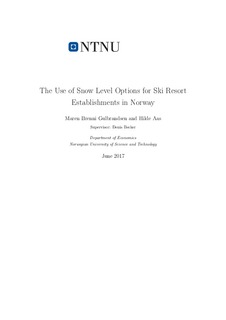| dc.description.abstract | Nearly all businesses are affected by the weather in one way or another. For many, the weather is considered one of the major uncontrollable risk factors (Sharma & Vashishtha, 2007). Especially, winter tourism is one of the sectors most sensitive to weather conditions (Damm & Greuell, 2016). A ski resort’s revenues are closely related to the cumulative snow level. A year with low snow levels can lead to a significant reduction in the firms revenues. We will look at the possibility to hedge this downside risk and thereby reduce cash flow volatility, by using weather derivatives as a short term risk management tool.
The weather derivative market is an incomplete market and traditional pricing methods are not applicable. Most of the existing literature on pricing methodology are with respect to temperature derivatives. Few have been conducted on snow level options.
The main objective of this study is to implement some of the few pricing methods that exists on snow level derivatives. These are the indifference pricing method, the method proposed by Alaton, Djehiche, and Stillberger (2002) (ADS) based on BlackScholes framework, a pricing method using historical densities and pricing by using generalized edgeworth series expansion. All of the above pricing methods are applied on a snow level put option constructed for Vassfjellet Skiheiser AS. The indifference prices for both seller and the buyer Vassfjellet are calculated, and the main assumption in the model saying that the buyer’s indifference price must exceed the seller’s indifference price, holds for all strike levels. For the most relevant strike levels, the prices generated by the different methods are surprisingly similar. This indicates that these pricing methods may be a good starting point for further application and modification.
By looking at historical data we observe a strong correlation between cumulative snow level data and Vassfjellet’s financial data. Further, we check if the volatility in Vassfjellet’s operating income the past years could have been reduced by investing in this snow level put option. The findings show that by buying a snow level put option each year from 2009-2015, the volatility in average operating income would decrease. Hence, if wishing to smooth income and hedge downside risk, the purchase of a snow level put option may be a good risk management tool. Our approach can be used on any individual ski resort who is exposed to snow level risk. | nb_NO |
